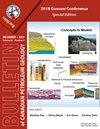萨斯喀彻温省东部上泥盆统-下密西西比统巴肯组沉积学、沉积技术及层序地层学
Q3 Earth and Planetary Sciences
引用次数: 4
摘要
在蒙大拿州东北部、北达科他州、马尼托巴省西南部和萨斯喀彻温省南部的威利斯顿盆地,上泥盆统-下密西西比统巴肯组的地下主要包括三段:下、上富有机质的黑色页岩,以及中灰质/白云质砂岩和粉砂岩,形成了一个包括烃源岩、储层和封闭层在内的“完美”含油气系统。在萨斯喀彻温东部,Bakken组被划分为8个相,其中一个相(相2)被细分为两个亚相:相1(平面交叉层状细粒砂岩);相2A(波状-闪状层状极细粒砂岩);2B相(薄平行层状极细粒砂岩和粉砂岩);相3(平行层状极细粒砂岩和泥质粉砂岩);相4(砂质粉砂岩);相5(高度生物扰动的层间细粒砂岩和粉砂岩);相6(互层高度生物扰动的砂质粉砂岩和微丘状交叉层状细粒砂岩);相7(高度生物扰动粉砂岩);相8(黑色页岩)。综合沉积学和技术研究表明,巴肯沉积发生在两种不同的古环境背景下:开阔海相(相4 ~ 8)和咸淡水边缘海相(相1 ~ 3)。开阔海相组合以远端克鲁齐亚纳相为特征,而咸淡水边缘海相组合以远端克鲁齐亚纳相为特征。等差线图显示,开阔海相和边缘海相沉积物在研究区内均有广泛分布,并提示南北向古海岸线的存在。研究区巴肯地层为两种不同的海侵体系域,由共面或层序边界与海侵面合并而成。在之前的研究中,研究区西南偏西已经确定了该表面,因此有助于巴肯地层的高分辨率对比。该地区巴肯组地层结构不寻常,这是由于其近侵位,有利于对先前积累的沉积物进行强烈的侵蚀和蚕食。本文章由计算机程序翻译,如有差异,请以英文原文为准。
Sedimentology, ichnology and sequence stratigraphy of the Upper Devonian–Lower Mississippian Bakken Formation in eastern Saskatchewan
The Upper Devonian–Lower Mississippian Bakken Formation in the subsurface of the Williston Basin in northeastern Montana, North Dakota, southwestern Manitoba and southern Saskatchewan typically includes three members: the lower and upper organic-rich black shale, and the middle calcareous/dolomitic sandstone and siltstone, which makes a “perfect” petroleum system including source rock, reservoir, and seal all within the same formation. In eastern Saskatchewan, the Bakken Formation is divided into eight facies, and one of which (Facies 2) is subdivided into two subfacies: Facies 1 (planar cross-stratified fine-grained sandstone); Facies 2A (wavy- to flaser-bedded very fine-grained sandstone); Facies 2B (thinly parallel-laminated very fine-grained sandstone and siltstone); Facies 3 (parallel-laminated very fine-grained sandstone and muddy siltstone); Facies 4 (sandy siltstone); Facies 5 (highly bioturbated interbedded very fine-grained sandstone and siltstone); Facies 6 (interbedded highly bioturbated sandy siltstone and micro-hummocky cross-stratified very fine-grained sandstone); Facies 7 (highly bioturbated siltstone); and Facies 8 (black shale). Our integrated sedimentologic and ichnologic study suggests that deposition of the Bakken occurred in two different paleoenvironmental settings: open marine (Facies 4 to 8) and brackish-water marginal marine (Facies 1 to 3). The open-marine facies association is characterized by the distal Cruziana Ichnofacies, whereas the brackish-water marginal-marine facies association is characterized by the depauperate Cruziana Ichnofacies. Isochore maps show that both open-marine and marginal-marine deposits are widely distributed in the study area and suggest the existence of a N-S trending paleo-shoreline. The Bakken strata in the study area represent two different transgressive systems tracts separated by a coplanar surface or amalgamated sequence boundary and transgressive surface. This surface has been identified in previous studies west-southwest of the study area, therefore assisting in high-resolution correlation of Bakken strata. The unusual stratigraphic architecture of the Bakken Formation in this area resulted from its proximal emplacement which favored intense erosion and cannibalization of previously accumulated deposits.
求助全文
通过发布文献求助,成功后即可免费获取论文全文。
去求助
来源期刊

Bullentin of Canadian Petroleum Geology
Earth and Planetary Sciences-Geochemistry and Petrology
CiteScore
2.50
自引率
0.00%
发文量
0
期刊介绍:
The Bulletin of Canadian Petroleum Geology is a peer-reviewed scientific journal published four times a year. Founded in 1953, the BCPG aims to be the journal of record for papers dealing with all aspects of petroleum geology, broadly conceived, with a particularly (though not exclusively) Canadian focus. International submissions are encouraged, especially where a connection can be made to Canadian examples.
 求助内容:
求助内容: 应助结果提醒方式:
应助结果提醒方式:


